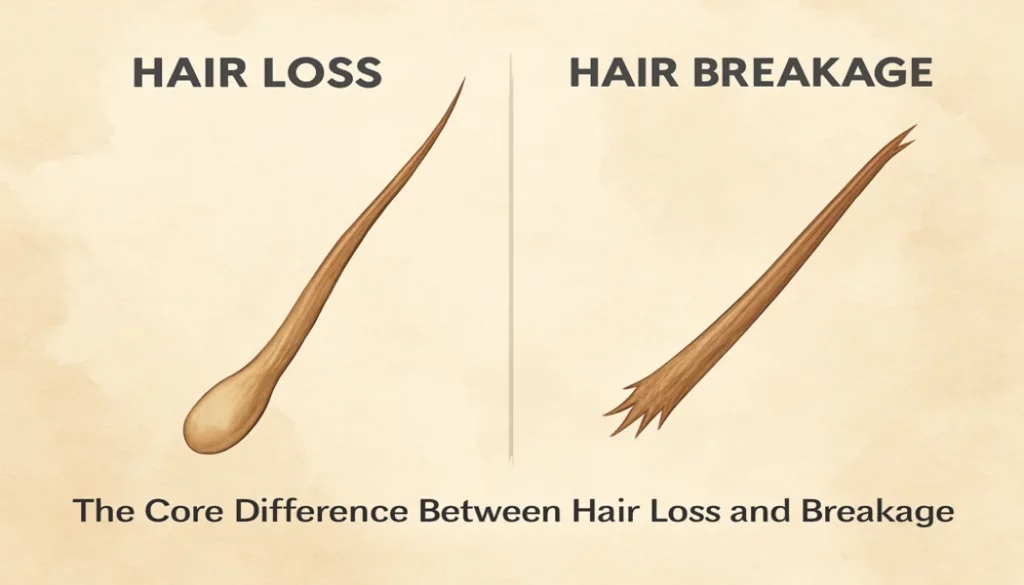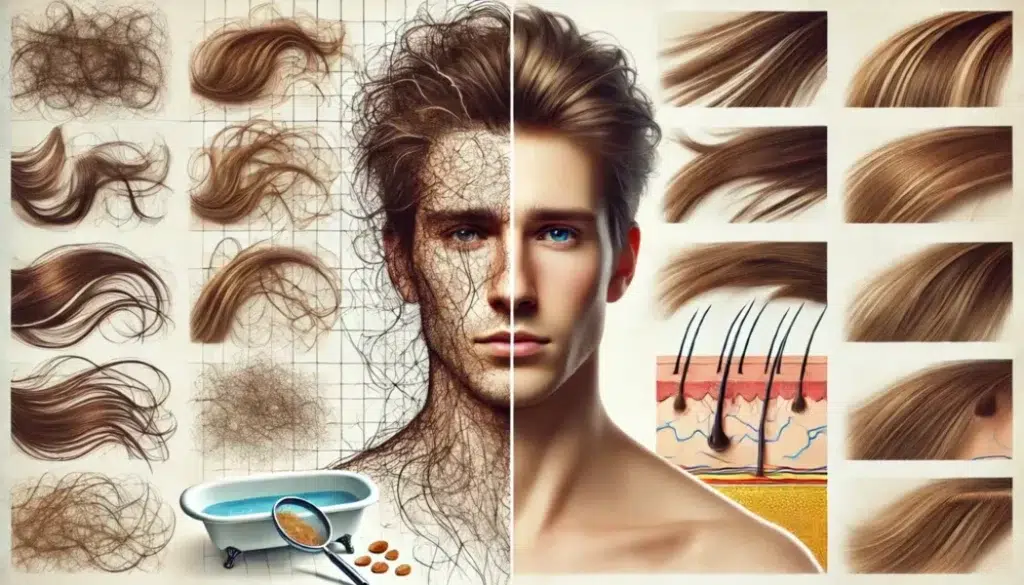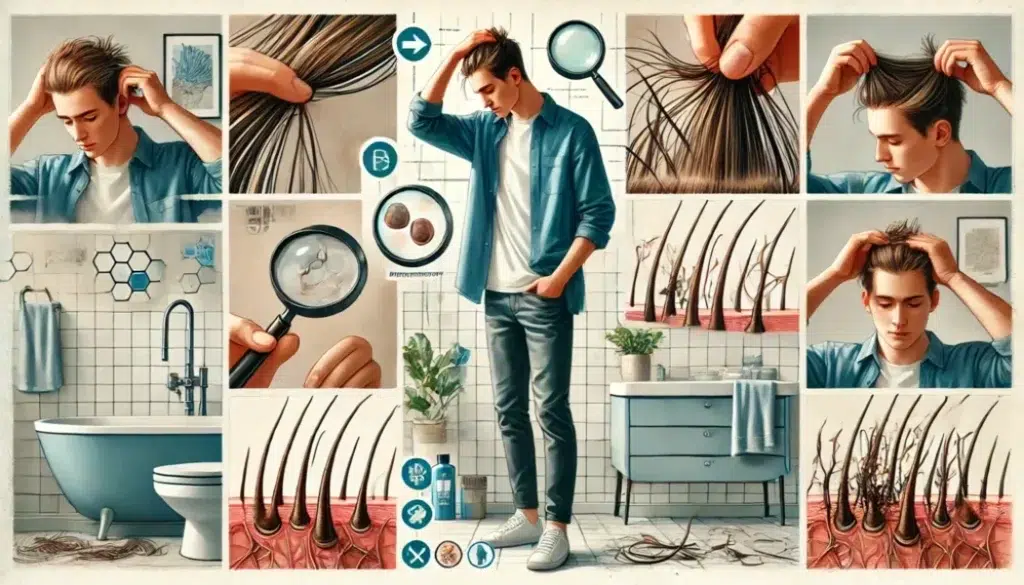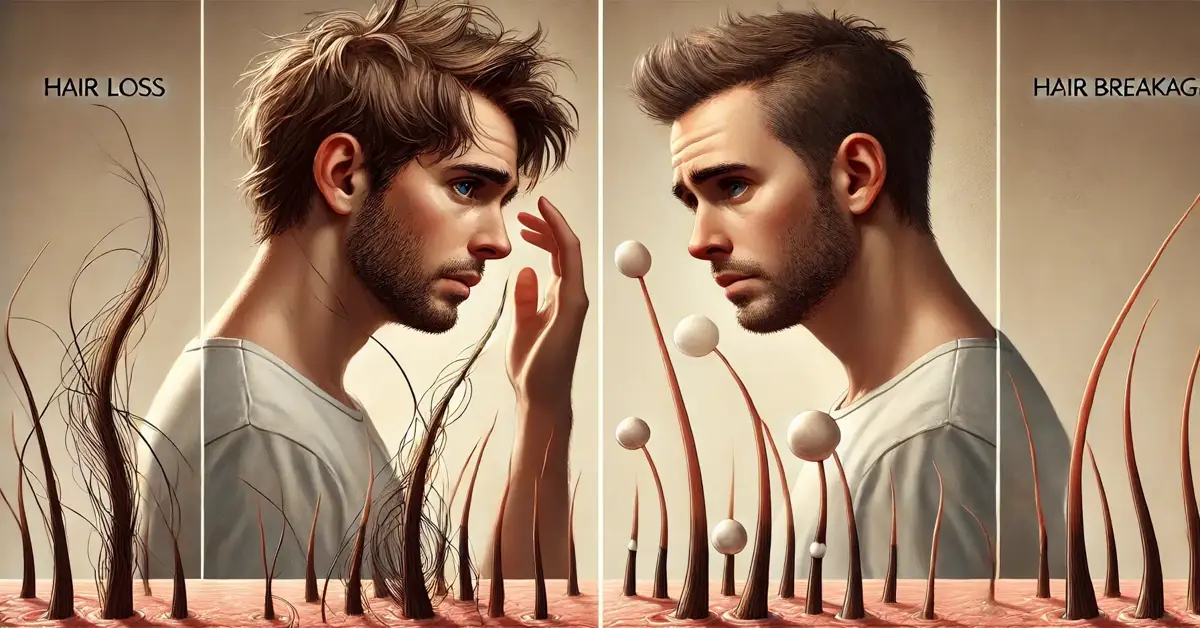When dealing with hair issues, it’s important to know what you’re up against. Hair loss, or ‘ispadanje kose’, refers to hair that falls out from the root. Picture this: strands with their little root bulbs at the ends. This issue can lead to thinning patches or reduced density on your scalp. That’s hair loss.
On the flip side, hair breakage, is about strands snapping off somewhere along the hair shaft. Imagine the mid-length or ends of your hair mysteriously shortening without your say. It results from damage to the hair structure, leaving your hair looking and feeling fragile.

So, how do these two differ at their core? With hair loss, you lose entire strands, roots and all. Hair breakage, however, results in those annoying flyaways and short wispy pieces that make styling a challenge. Recognizing which issue you have is key to treating it effectively.
🔍 Identifying the Causes: Triggers of Hair Issues
Hair issues don’t just pop up out of nowhere. They’re often the result of triggers you might not even be aware of. Hair loss can stem from genetics, hormonal changes, stress, or underlying health conditions. Think about those times when life gets a bit too hectic — yes, that stress can take a toll on your locks too.
When it comes to hair breakage, it’s a different story. Heat styling tools like flat irons and curling tongs can be your hair’s worst enemy. Chemical treatments can strip away moisture, leaving strands dry and fragile. Even simple habits, like how we brush or style, can contribute to breakage.

It’s important to understand how both lifestyle and the environment affect your hair. Sun exposure, pollution, and diet all play a role. Being aware of these risks means you can adjust your routine and protect your hair.
👁️ Spotting the Signs: Visuals and Key Indicators
Recognizing whether you’re dealing with hair loss or breakage starts with a close look at your strands and scalp. With hair loss, you’ll notice complete strands on your pillow or in the shower drain — usually with little roots attached. This often results in thinning, where the scalp becomes more visible as volume decreases.
Hair breakage, however, is all about the strands themselves. Watch for brittle ends that snap off easily, causing uneven lengths and frizz. If you’ve been wearing tight ponytails or overdoing heat styling, look for short, broken pieces in those areas.

The location can also offer clues. Hair loss typically affects broader areas like the crown or hairline. Breakage tends to be random, targeting weakened sections. Spotting the signs early helps you tailor your care to the actual problem.
🧪 Self-Diagnosis and Testing at Home
Checking your hair at home can reveal whether you’re facing hair loss or breakage. The pull test is a simple method: gently tug a small section of hair and see how much comes out. A few strands are normal; more might indicate hair loss.
Another trick is the magnifying glass test. Look closely at fallen strands. Root bulbs? That’s hair loss. Frayed or split strands? Likely breakage.
These small checks help you make better decisions about hair care. If breakage is the issue, ease up on heat styling. If it looks like hair loss, you might want to review your health or products. And when in doubt, professional advice never hurts.

💡 Preventing and Treating Hair Loss & Breakage
Taking control of hair issues starts with prevention. For hair loss, a healthy lifestyle is key. Eat a balanced diet rich in vitamins and minerals. Managing stress through yoga, meditation, or daily walks can also help.
To prevent hair breakage, focus on hydration and protection. Use leave-in conditioners and hair masks regularly. Limit heat styling and chemical treatments. Natural hairstyles can give your strands a much-needed break.
Choose products that match your hair concerns. Strengthening proteins and oils help with breakage. For hair loss, look for scalp-stimulating ingredients like caffeine or biotin.
If problems continue despite your efforts, consult a dermatologist or trichologist. They can offer tailored treatments and put you on the right path to healthier hair.
Stay with us — the best is yet to come.
By following our advice, you’re doing the most you can for your hair.
Be the first to know when we publish new guides, tests, and proven strategies for stronger, healthier hair.
👉 Visit the About Me page to learn more about my journey, mission, and why helping people with hair health is so personal to me.
Want healthier, stronger hair? Discover 8 science-backed habits that protect your scalp and boost natural growth. Get your free PDF guide today!
Disclaimer: This article is for informational purposes only and is not a substitute for professional medical advice. Sensitive claims are supported with scientific references, and full product details can always be found on the official websites of the respective manufacturers or distributors.
Some links in this article are affiliate links. If you choose to make a purchase through them, I may earn a small commission at no extra cost to you — helping me keep HairGrowGenius running. Thank you for your support!

✅ FAQ – The Difference Between Hair Loss and Hair Breakage
❓ How can I tell if I’m losing hair from the root or just experiencing breakage?
Check the strand: if it has a tiny white bulb at the end, it’s likely shed from the root (hair loss). If it’s broken mid-shaft without a bulb, it’s hair breakage. Also, breakage often happens in uneven, frizzy patches, while shedding tends to be more diffuse.
❓ Can stress cause both hair loss and breakage?
Yes. Chronic stress can disrupt the hair growth cycle (leading to shedding) and increase cortisol levels, which may weaken the hair shaft structure. The result? Double trouble: more fallout and weaker strands prone to snapping.
❓ Are different shampoos recommended for breakage vs. hair loss?
Absolutely. Breakage-prone hair benefits from strengthening shampoos with proteins (like keratin or hydrolyzed wheat protein), while hair loss treatments focus on stimulating follicles with ingredients like caffeine, rosemary, or minoxidil.
❓ Does using heat tools contribute more to hair breakage than hair loss?
Yes. Blow dryers, flat irons, and curling wands dry out and weaken the hair shaft, making it more likely to snap. They don’t affect the follicle directly, so the damage is external—classic breakage territory, not root-level shedding
Last updated: June 2025 based on latest research


Leave a Reply